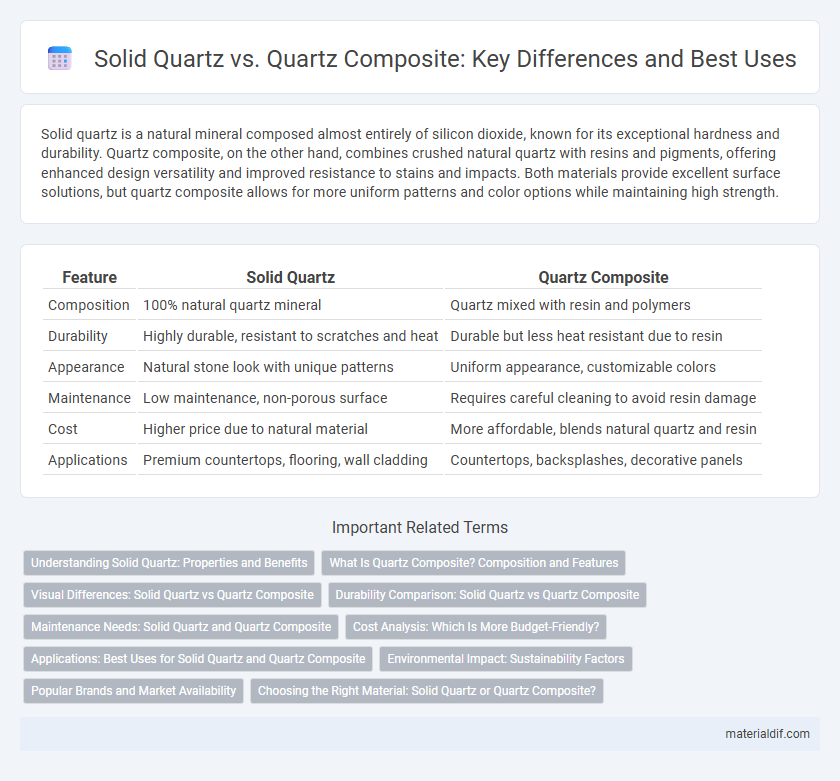Solid quartz is a natural mineral composed almost entirely of silicon dioxide, known for its exceptional hardness and durability. Quartz composite, on the other hand, combines crushed natural quartz with resins and pigments, offering enhanced design versatility and improved resistance to stains and impacts. Both materials provide excellent surface solutions, but quartz composite allows for more uniform patterns and color options while maintaining high strength.
Table of Comparison
| Feature | Solid Quartz | Quartz Composite |
|---|---|---|
| Composition | 100% natural quartz mineral | Quartz mixed with resin and polymers |
| Durability | Highly durable, resistant to scratches and heat | Durable but less heat resistant due to resin |
| Appearance | Natural stone look with unique patterns | Uniform appearance, customizable colors |
| Maintenance | Low maintenance, non-porous surface | Requires careful cleaning to avoid resin damage |
| Cost | Higher price due to natural material | More affordable, blends natural quartz and resin |
| Applications | Premium countertops, flooring, wall cladding | Countertops, backsplashes, decorative panels |
Understanding Solid Quartz: Properties and Benefits
Solid quartz is a natural mineral known for its exceptional hardness, durability, and resistance to scratches and stains, making it ideal for various applications including countertops and tiles. Its non-porous surface prevents bacterial growth and requires minimal maintenance compared to porous materials. These properties contribute to its popularity in both residential and commercial environments, ensuring longevity and aesthetic appeal.
What Is Quartz Composite? Composition and Features
Quartz composite consists of natural quartz particles combined with resins, polymers, and sometimes pigments to create an engineered stone. This material offers enhanced durability, non-porosity, and consistent coloration compared to natural solid quartz, making it highly resistant to stains and scratches. Quartz composite is widely used in countertops and surfaces due to its low maintenance and versatile design options.
Visual Differences: Solid Quartz vs Quartz Composite
Solid quartz features a consistent, uniform color and pattern throughout the slab, lending a natural and seamless appearance ideal for elegant countertops. Quartz composite, composed of crushed quartz mixed with resin and pigments, exhibits more varied patterns and vibrant colors, often mimicking natural stone with added design flexibility. The visual difference highlights solid quartz's subtle, monochromatic look versus the composite's potential for intricate veining and color diversity.
Durability Comparison: Solid Quartz vs Quartz Composite
Solid quartz exhibits superior durability due to its almost 100% natural quartz content, making it highly resistant to scratches, heat, and staining compared to quartz composite, which contains a blend of quartz and resin. Quartz composite surfaces, while still durable, may be more susceptible to damage from prolonged exposure to heat or sharp impacts because of the resin content. The dense, hard structure of solid quartz ensures longer-lasting performance in high-traffic or heavy-use areas.
Maintenance Needs: Solid Quartz and Quartz Composite
Solid quartz offers superior durability with minimal maintenance, resisting scratches and stains without requiring sealing. Quartz composite, while also low-maintenance, may demand occasional resealing and is slightly more prone to surface damage due to its mixed material composition. Both materials benefit from regular cleaning with mild soap and water to maintain their aesthetic appeal and longevity.
Cost Analysis: Which Is More Budget-Friendly?
Solid quartz typically carries a higher upfront cost due to its natural durability and uniform appearance, making it a premium option for countertops and surfaces. Quartz composite, combining quartz with resins and other materials, offers a more budget-friendly alternative with lower material and installation costs while maintaining decent strength and aesthetic appeal. For cost-conscious projects, quartz composite provides a balance between affordability and performance, whereas solid quartz is preferred for long-term investment and luxury finishes.
Applications: Best Uses for Solid Quartz and Quartz Composite
Solid quartz is ideal for high-traffic surfaces like kitchen countertops and commercial flooring due to its exceptional durability and resistance to scratches and heat. Quartz composite, combining natural quartz with resins and pigments, excels in decorative applications such as wall cladding, bathroom vanities, and custom furniture, offering greater design versatility and color options. Both materials perform well in residential and commercial settings but differ in flexibility and application scope, with solid quartz favored for durability-intensive tasks and quartz composite preferred for aesthetic-driven projects.
Environmental Impact: Sustainability Factors
Solid quartz is a natural stone with minimal processing, resulting in a lower carbon footprint compared to quartz composite, which combines crushed quartz with resins and polymers. The production of quartz composite involves synthetic materials and chemicals that increase environmental impact and complicate recycling efforts. Choosing solid quartz supports sustainability efforts due to its durability, natural extraction, and reduced reliance on petrochemical additives.
Popular Brands and Market Availability
Solid quartz surfaces, known for brands like Caesarstone, Silestone, and Cambria, dominate the premium countertop market with their 90-95% natural quartz content and superior durability. Quartz composites, often offered by companies such as HanStone and LG Hausys, blend quartz with resins and pigments, providing a wider range of colors and cost-effective options. Market availability for solid quartz is concentrated in high-end retailers and specialty stone distributors, while quartz composites are more commonly found in large home improvement stores and online marketplaces.
Choosing the Right Material: Solid Quartz or Quartz Composite?
Solid quartz offers unparalleled durability and a natural aesthetic due to its 100% natural composition and high quartz content, making it ideal for high-traffic surfaces and heat resistance. Quartz composite, blending natural quartz with resin and pigments, provides enhanced design flexibility and uniformity, with improved stain and impact resistance for customized interior applications. Selecting between solid quartz and quartz composite depends on the balance between natural beauty, durability needs, and aesthetic versatility to match specific project requirements.
Solid Quartz vs Quartz Composite Infographic

 materialdif.com
materialdif.com